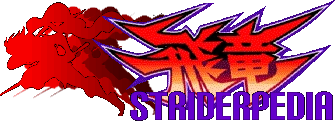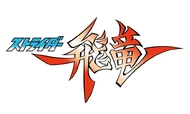The Strider series or Strider Hiryu series (ストライダー飛竜シリーズ)[1] is a video game series developed and owned by Capcom, starring the high-tech ninja-like mercenary Hiryu.
Although not a big seller for Capcom, Strider has remained a cult classic which has inspired both directly and indirectly a plethora of other games with its high-speed, intense action gameplay and set-pieces; and Hiryu himself has remained a popular and influential character in Capcom's repertoire, primarily among enthusiasts of the fighting game genre.
History[]
- For a full list of games starring Hiryu, see Games.
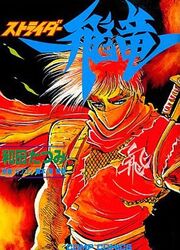
The original manga
Strider started out as an inter-company multi-media project, the first ever big joint project developing both video games and a manga in the industry[2]. Capcom and the manga collective Moto Kikaku worked together in order to develop the series in three different directions: a serialized manga, a video game for home consoles and a video game for Arcades, all under the same title: Strider Hiryu.
Moto Kikaku released the manga first in between May and October 1988, lasting for 6 chapters plus a 7th, extra bonus chapter released in December. Drawing from 21st Century Humanism[2], the manga's plot centers on Hiryu and his best friend Kain, members of a modern ninja-like mercenary organization known as Striders, as they battle against the corrupt organization Enterprise and a traitor faction within the Striders working together in a plan to take over humanity's free will. The manga was drawn by Moto Kikaku's Tatsumi Wada and written by Tetsuo Shiba.
Due to the collaboration, Moto Kikaku is usually listed in the copyright line for any game Hiryu makes an appearance.
Strider (CPS-1)[]
- Main article: Strider (CPS-1)
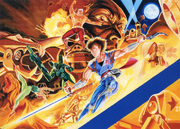
Flyer for the Arcade game
The Arcade version of the project was led by Kouichi Yotsui and developed as the 3rd game in Capcom's then-new CP System (CPS-1) Arcade board. Initially scheduled for December 1988, it suffered delays and was finally released on March 1989 worldwide. Set in the year 2048, Hiryu is an active member of Striders and is tasked the most dangerous mission: to assassinate Grandmaster Meio, the ruler of the entire world. Grandmaster Meio is a mysterious being that appeared out of nowhere and, after 5 years of war, conquered Earth. Now wishing to become a real God, Meio plans on killing off all life on its surface so he can repopulate it with lifeforms of his making. In the now-rebranded "Meio Year One", Hiryu begins his mission by infiltrating Meio's seat of power on Earth, the Kazakh Federation. Along the way he'll be opposed not only by Meio's loyal followers, but paid bounty hunters and assassins out for his head.
Out of the three projects the Arcade Strider was the most successful, particularly in North America and Europe. Ports for several European home computers and the PC Engine were quickly announced. The former were developed by Tiertex and U.S. Gold and received positive reviews in spite of their shortcomings, while the latter went into year-long hiatus and hardware changes until it was finally released in 1994. A port for Sega's Mega Drive was released in 1990 and became an early Killer App for the console.
Strider (NES)[]
- Main article: Strider (NES)
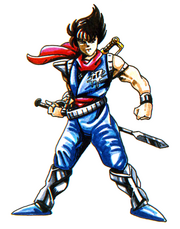
Hiryu's art for the cancelled Famicom version
The home consoles project was led by Masahiko Kurokawa and planned to be released on the Famicom in October 1988, but for unknown reasons it was delayed and eventually cancelled in Japan. Despite this, an English version of the game for the NES saw release exclusively on North America in July 1989. Also set in the year 2048, the game follows the plot of the manga closely and features Hiryu as he embarks on a quest to uncover the secrets behind the ZAIN Project and stop the ambitions of its creators. Most of the characters from the manga appear during the game in basically the same roles.
Unlike the Arcade game, Strider for the NES was not as well received due to a notable lack of polish in what seems to be a quick rush job to translate and release the game, and its slower and simpler gameplay being overshadowed by the Arcade game's more impressive visuals, acrobatics and speed.
Resurgence[]
Concepts for a sequel were brainstormed within Capcom of Japan during the early 90s', but they were all abandoned following the release of Street Fighter II and the subsequent fighting game boom it initiated. In between 1990 and 1993 U.S. Gold and Tiertex took advantage of the license to produce their own European sequel to the first game, Strider II (Journey from Darkness: Strider Returns in America). Originally developed as an entirely different game, Strider II managed a good overall reception but over the years gained infamy as a vastly inferior product, and Capcom has since removed it from official canon.
The series would remain dormant for the following 10 years, barring ports and minor cameos by Hiryu, until Hiryu's return to the spotlight as one of the playable characters in Marvel vs. Capcom: Clash of Super Heroes. Hiryu's updated redesign and fast-paced gameplay gained him a following and he instantly became a fan favorite of the fighting series, specially among the Western fandom. This new-found popularity would inspire Capcom to greenlit development of a brand-new entry in the series.
Strider 2[]
- Main article: Strider 2
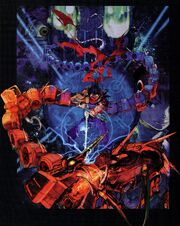
Key artwork, by Harumaru
Strider 2 was first announced in February 1998 as a 2D platform Arcade game with 3D polygonal backgrounds, and went over a troubled development that almost saw it cancelled, but thanks to the determination of director Atsushi Tomita finally saw release on December 1999. Set 2000 years after the original Arcade game, Strider 2 sees a decadent modern world under the leadership of Grandmaster Meio's created humans, ruling in his name. The Striders are exterminated following the betrayal of one of their own, who releases Meio from his burial chamber in order to reclaim the world. Hiryu, a Strider carrying the same codename of the one who defeated Grandmaster Meio in the past, is given his elimination as the Striders' final order, and he takes it upon himself to complete his mission even if he has to face the entire world and his former friend, the traitorous Strider Hien.
Released in 1999 for Arcades and 2000 for the PlayStation, Strider 2 was well-received but became a commercial flop. Following this, the series went back into hibernation, although Hiryu himself remained a frequent choice for crossover games in the following years.
Strider (2014)[]
- Main article: Strider (2014)
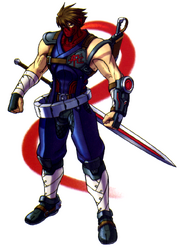
Hiryu's new look
Although dormant, rumors about Capcom considering a new game in the series were regularly brought up in the following years. In 2002 Capcom Production Studio 1's producer Katsuhiro Sudō expressed interest in developing a full 3D Strider for Xbox[3], but he'd leave the company in April 2004 following the studio's closure. In 2009 there was an attempt to pitch a Strider reboot worked on by the Swedish studio GRiN, but the project was shelved before getting anywhere following the company's bankrupcy.
Around the early 2010s' a second, unrelated pitch was done by Double Helix Games as one of many other pitches for classic Capcom series. Impressed by their presentation and the passion shown for the IP, Capcom greenlit and assisted Double Helix in a brand new installment of the series. Titled simply Strider, it was released on February 2014 digitally for Xbox 360, PlayStation 3, Xbox One, PlayStation 4 and PC. Strider was well-received by fans and critics and eventually managed to sell 1 millon units, becoming the best-selling game in the series.
Set in the fictional year of "Meio 0048", Strider sees a retelling of the core series' plot: Grandmaster Meio is the tyrannical ruler of the entire planet, overseeing it from his base at Kazakh City. Following several failed attempts at eliminating him, the Striders tasks Hiryu the mission as their final hope to stop his plan to erradicate the life on the planet and give way to a perfect race of his own making. Although often referred by the media as a reboot of the series, Strider is not considered one by Capcom or its developers, who instead call it a "brand new retelling" of the setting for modern audiences. With official statements denying it to be a reboot or remake of the first game[4], replacement of any previous game[5] or canon[6], or an alternate universe[7], it is uncertain what kind of connection the game has to the overall series, if any.
Gameplay[]
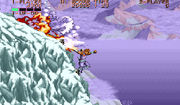
Running down a mine-filled mountain in Siberia
Officially classified under the "Stunt Action" (スタントアクション) genre label, gameplay in Strider focus primarily on high-speed platforming, granting the player complete freedom of movement in any terrain and a limited but powerful arsenal of abilities stemming from the protagonist's sole weapon, a sword of plasma known as Cypher. Hiryu's acrobatic abilities are one of the series' selling points, with players being able to jump at any direction, dash, slide, cartwheel forward and even cling to any surfaces and climb across any terrain effortlessly and smoothly. Hiryu's main offensive, a blindingly fast-repeating sword slash, grants him incredible reach and allows to eliminate most enemies extremely quickly. Stages also feature a large variety of unique situations and set-pieces, including memorable sections where Hiryu has to outrun mines while running down the side of a mountain and face enemies upside-down while in reverse-gravity.
As the games were developed to be played repeatedly (given their nature as Arcade games), Strider games are short and quick to complete, placing its emphasis primarily on learning layouts and mastering the controls with the goal of getting better at completing each stage as perfectly and fast as possible.
The NES and 2014 version Strider feature a slightly different gameplay style, focusing more on exploration and discovery of items and abilities that are required to proceed. The NES Strider featured basic elements of what'd come to be known as the "Metroidvania" genre, becoming a slower-paced game with little in common to its Arcade counterpart. The 2014 Strider merged the two gameplay styles and went against some of the typical Metroidvania conventions, offering a fast-paced exploration-based video game where Hiryu starts out powerful and becomes even stronger as the player makes progress, unlocking moves that allow him to access new areas, dodge and counterattack against hordes of enemies or find and reach one of several collectable items.
As a reflect of this gameplay change, the game's genre is redefined and listed as "High-Speed Exploration Action" (ハイスピード探索アクション).
Recurring Characters[]
- For a full list of characters, see Characters.
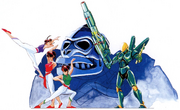
Tong Pooh and Solo, two of Hiryu's recurring rivals
The Strider series features a small number of recurring characters that appear in most games, as well as having regular crossover appearances.
- Hiryu: The main character of the series, the strongest member of the Striders and the youngest to ever attain their top ranking, Special-A Class. Hiryu is a young man of few words and incredible skills, often tasked the most dangerous missions.
- Grandmaster Meio: The main antagonist of the series, a mysterious individual whose main goal is to become a God through the creation of life to replace the living organisms on Earth.
- Tong Pooh: The leader of the assassin and bounty hunter trio known as the "Kuniang M.A. Team", together with her sisters Pei Pooh and Sai Pooh. Tong Pooh is a skilled martial artist with a fierce personality and complete devotion to Grandmaster Meio and his cause.
- Solo: An invincible bounty hunter who fights with ranged weaponry and a flight-capable armor. Hired by the enemies to stop Hiryu, Solo profess a belief he's unrivaled as the strongest human but sees his claim challenged once he comes face to face with his target.
- Hien: Introduced in Strider 2, a former Strider and Hiryu's colleague who betrayed the organization and joined Grandmaster Meio. Although close if not equal to Hiryu in skill, Hien's perceived inferiority when compared to Hiryu's achievements turns his former friend into his greatest rival.
Related Games[]
Marvel vs. Capcom series[]
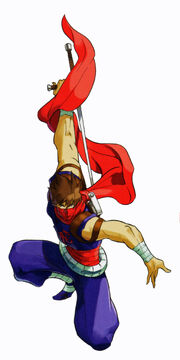
Hiryu's appearance in the first game
The Marvel vs. Capcom series is as much important to Hiryu's legacy as his own series, having brought Hiryu back from obscurity and making him a fan favorite among Capcom's characters.
Hiryu has been a recurring playable character in the series since its third entry, Marvel vs. Capcom: Clash of Super Heroes, released on 1998. He quickly became a player favorite, specially in western regions, and his increased popularity eventually led to the release of Strider 2. This incarnation of Hiryu features a fast-paced gameplay style with several ranged attacks and the employ of his mechanical Options for assistance. Hiryu would return, virtually unchanged, in 2000's Marvel vs. Capcom 2: New Age of Heroes, where his popularity grew further.
Although Hiryu did not made the cut for the roster in Marvel vs. Capcom 3: Fate of Two World, the fan demand that followed led to him being one of the first confirmed characters for its late 2011 updated release, Ultimate Marvel vs. Capcom 3[8]. Hiryu also was one of Capcom's 15 initial characters in the follow-up and currently last entry in the series, 2017's Marvel vs. Capcom: Infinite.
Besides Hiryu, other series characters such as Tong Pooh, Grandmaster Meio and Hien have been featured in minor roles or cameos as well.
Street Fighter[]
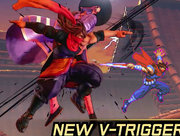
Zeku's appearance and technique harken back to Hiryu
Although Strider has had minor cameos and references in the long history of Capcom's Street Fighter fighting game series, it wasn't until 2017's Street Fighter V when the two series became strongly connected.
Street Fighter V reintroduced the Street Fighter Alpha minor character Zeku as a playable character with an age-switching mechanic. Zeku's young appearance was designed to heavily resemble Hiryu and his backstory and techniques feature several nods to Hiryu and the Strider series. Most importantly, his story of seeking to establish a new modern organization heavily implies he is (or will be) involved in the creation of Hiryu's group, the Striders. Zeku's backstory setting also establishes the original 1989 Hiryu as being his direct successor.[9]
This new development appears to indicate the Strider series is being set in the future of the Street Fighter world, including it in Capcom's Street Fighter-centric "shared universe" alongside other series such as Final Fight, Slam Masters and Rival Schools. Whether these ties are meant as such or are simply referential in nature is currently uncertain, however.
Spiritual successors[]
Although Kouichi Yotsui left Capcom shortly after the release of the first game and hasn't been involved in any of its sequels, he developed two action games that closely mimic the gameplay of Strider, and which he has referred to his own sequels to it.
Cannon Dancer (released in English as Osman) is a 1996 Arcade platformer developed by Kouchi Yotsui for Mitchell Corp, starring a mercenary martial artist known as Kirin on a mission to get revenge after being betrayed by his contractor. Cannon Dancer was developed as a "self-parody" of his work in Strider and features nearly identical gameplay spiced with new elements and techniques, and a more elaborate doppelganger system. Referred by Yotsui as being his Strider 2, there are subtle hints in its backstory tying the two games together. Cannon Dancer has been recognized as a spiritual successor by Capcom as well, and some minor references were included in Zeku's design.[9]
Moon Diver is a 2010 online co-op platformer with light RPG elements and the third action game developed by Kouichi Yotsui, this time for Square-Enix. Taking elements from his two previous action games, Moon Diver displays the same fast-paced, highly acrobatic gameplay seen in Osman and Strider. Yotsui has also called it "a sequel to the action games" he has made in the past, and subtle nods and references to past plot points can be found in its backstory.
The two games also have nods and references to many other games Yotsui has directed during his career, seemingly establishing a sort of very loose unofficial "shared universe" between most of his works.
References[]
- ↑ Capcom (2013). "Introduction". Capcom's official Strider site (Japanese). Retrieved from archive.org. Accessed November 11, 2021.
- ↑ 2.0 2.1 "Strider Hiryu Japanese Magazine Scans". Marukatsu Famicom, October 1988 issue.
- ↑ Staff (September 2, 2002). "World Exclusive: Strider 3 for Xbox enters Capcom's thoughts?". spong.com. Accessed November 3, 2020
- ↑ Gillbert, Henry (July 22, 2013). "Strider isn't a reboot, it's a retelling". gamesradar.com. November 3, 2020
- ↑ McFerran, Damien (January 29, 2014). "Strider: Remaking an arcade classic". redbull.com. Accessed November 3, 2020
- ↑ Hickey Jr., Patrick (January 3, 2020). The Minds Behind Adventure Games: Interviews with Cult and Classic Video Game Developers. "Even Better Than the First Time", pg. 208-214. ISBN 1-4766-3847-0.
- ↑ Emmanuel (February 21, 2014). "Interview with "Strider Hiryu" producer! Talks about the reborn action exploration game which will please series' fans" (Japanese). dengekionline.com. Accessed November 3, 2020
- ↑ Spencer (July 22, 2011). Interview with Ryota Nitsuma. Siliconera.com. Accessed November 3, 2020
- ↑ 9.0 9.1 Staff (November 30, 2018). How to Make Capcom Fighting Game Characters (Japanese). Pg. 020. Born Digital. ISBN 4-86246-432-7.
| Strider video game series |
|---|
| Games |
| Strider (Home computers • Mega Drive • Master System • PC Engine • Sharp X68000 • PlayStation • Mobile) Strider (NES) • Strider II/Returns • Strider 2 • Strider (2014) Compilations • Crossovers • Related Games |
| Characters |
| Hiryu • Grandmaster Meio • Solo • Kuniang M.A. Team Tong Pooh • Hien • General Mikiel • Ouroboros |
| Recurring Elements |
| Striders • Cypher • Climb Sickle • Options • Kazakh Federation Anti-Gravity Device/Gravitron • Mecha Pon • Flying Battleship Balrog • The Third Moon |
| Other Articles |
| Capcom • Moto Kikaku • Tiertex Design Studios • Double Helix Games Isuke • Patariro • Other key staff • Strider Hiryu (Manga) • Capcom Gamebooks Merchandise • Soundtracks |
